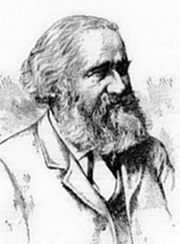Alexander N. Aksakof
 1832-1903
1832-1903
Imperial Councilor to the Czar, the pioneer spiritualist of Russia, a Swedenborg enthusiast whose introduction to modern spiritualism was effected by Andrew Jackson Davis’s “Nature’s Divine Revelations” in 1855. In order to form a correct judgment of both physiological and psychological phenomena he studied medicine at the University of Moscow for two years. He translated Swedenborg’s “Heaven and Hell”, Count Szapary’s “Magnetic Healing” and the principal works of Prof. Hare, Crookes, Edmonds, Owen and the “Report of the Dialectical Society”. As, however, works on spiritualism in
Russian were suppressed by the censor but German publications were tolerated, his literary activity, of a necessity, centred in Germany. He founded the Psychische Studien which, under the changed title Zeitschrift far Parapsychologie, is still running, and was instrumental in provoking the first strictly scientific Russian investigation of spiritualism.
D. D. Home visited Russia for the first time in 1861. He became connected, through marriage, with Aksakof’s family and was in 1871 introduced by him to Prof. Boutlerof, and to other professors of the University of St. Petersburg. However, the body of savants was left unconvinced. In 1874 the French medium, Camille Bredif paid a visit. Professor Wagner attended a seance and was deeply impressed. His article in the “Revue de l’Europe” aroused such a storm that the University felt impelled to delegate an investigating committee and asked Aksakof to make the necessary arrangements for
them. Aksakof went to England in 1875 and engaged, after a previous failure with the Petty Brothers of Newcastle, a non-professional medium, using the name of Mrs. Clayer, to whom he was introduced by Crookes, for presentation to the committee. The lady, who is mentioned in Crookes’ “Researches” on pages 38-39, produced strong physical phenomena in light. The committee, however, refused to be impressed and Prof. Mendeleyeff, its principal member, in his report “Materials by Which to Judge Spiritualism”, declared that the medium had an instrument under her skirts and produced
table movements and raps by this agency. To this report Aksakof returned, under the title “A Monument of Scientific Prejudice, a caustic reply”. In 1876 he asked permission to publish in St. Petersburg a monthly, “Review of Mediumship”. It was refused.
Thereupon, in 1881, an organ with an unmeaning title, “Rebus”, was founded and largely subsidised, after funds went low, by Aksakof to popularise the teachings of Spiritualism.
He experimented with Slade and Williams when they visited St. Petersburg and he madearrangements for Mrs. Kate Fox-Jencken when the Czar desired to consult her for thesafe conduct of the coronation ceremonies. Eglinton, Mme. d’Esperance and Eusapia Paladino were the next mediums who engaged his attention. His wife herself was mediumistic and became thereby a help in his work. In a “Case of Partial Dematerialisation” (1896) he recorded testimonies of an astounding occurrence with Mme. d’Esperance. His most important book, “Animismus und Spiritismus”, Leipzig, 1890 was published in answer to Dr. Edward von Hartmann’s “Spiritualism”. Myers, in his review in Proceedings, Vol. VI. p.665, states: “I may say at once that on the data as
assumed I think that Mr. Aksakof has the better of his opponent.” In the book Aksakof says that for the comprehension of mediumistic phenomena we have not one hypothesis only, but three hypotheses: 1. Personism (or change of personality) may stand for those unconscious psychical phenomena which are produced within the limits of the medium’s own body, those intra-inediumistic phenomena whose distinguishing characteristic is the
assumption of a personality changing to that of the medium. 2. Under the name animism we include unconscious psychical phenomena which show themselves outside the limits of the medium’s body. Extra-mediumistic operation of objects without contact and finally materialisation. We have here the highest manifestation of the psychic duplication; the elements of personality overstep the limits of the body . . . up to the point of complete
externalisation and objectification. 3. Under the name spiritism we include phenomena resembling both personalisation and animism but which we much ascribe to some extra-mediumistic and extra-terrene cause. They differ from the phenomena of personalisation and animism in their intellectual content which affords evidence of an independent personality.
“Spiritualism and Science” was another of Aksakof’s important works. His literary output was considerable. One of his last translations was Col. Rochas’ “Exteriorisation of Motricity”. Under dreadful physical handicaps he kept on working to the last. His right hand became useless, his eye almost sightless. A final attack of influenza on January 17th, 1903, carried him away.
Source: http://www.survivalafterdeath.org/scientists/1.htm
